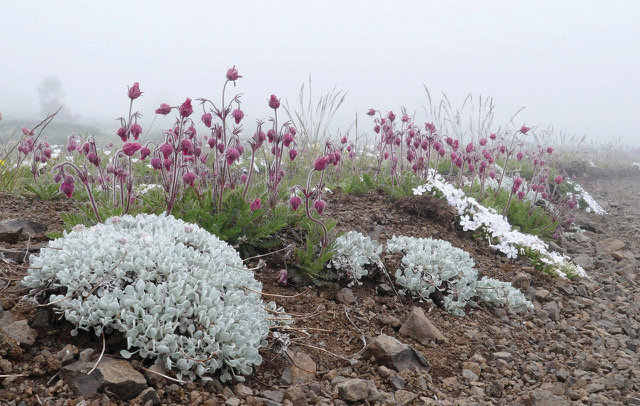Two weeks ago, while trekking across the broad summit of Mount Townsend in thick fog, we unexpectedly crossed paths with several groups of friends from town who were also out botanizing high in the …
This item is available in full to subscribers.
We have recently launched a new and improved website. To continue reading, you will need to either log into your subscriber account, or purchase a new subscription.
If you had an active account on our previous website, then you have an account here. Simply reset your password to regain access to your account.
If you did not have an account on our previous website, but are a current print subscriber, click here to set up your website account.
Otherwise, click here to view your options for subscribing.
* Having trouble? Call our circulation department at 360-385-2900, or email our support.
Please log in to continue |
|

Two weeks ago, while trekking across the broad summit of Mount Townsend in thick fog, we unexpectedly crossed paths with several groups of friends from town who were also out botanizing high in the subalpine tundra.
The wildflowers were glorious, but what is always extra special is seeing plants that thrive at sea level now blooming at higher elevations in the mountains. Finding these native plants on a high mountain pass so far from home feels a lot like running into old friends.
If you‚‘ve been following this column since it began in early April this year, but didn’t make it out during the peak blooms around town this spring, you can enjoy spring again a few thousand feet higher. A sharp-eyed hiker can find fairy slipper orchids flowering along Silver Creek and Deer Ridge trails. Pacific rhododendrons are still flourishing along the first mile or so of trails to the summits of Mount Zion and Mount Townsend. The tiny but brilliant flowers of blue-eyed Mary that were blooming in April on the back dunes of Point Wilson beach are now beaming among mounds of phlox along Klahane Ridge in Olympic National Park.
Most fascinating to me is that many of the plants that flourished in Kah Tai Prairie in Port Townsend when it was in full glory in April and early May can be seen blooming at higher elevations in July.
In lowland prairies, blue camas dominates the scene in spring, drawing hundreds of admirers and photographers. In between the mesmerizing sea of camas, there were also more modest blossoms, including biscuitroot, chocolate lily, prairie smoke, purple broomrape, common chickweed, Menzie‚‘s larkspur, woolly sunflower, lupines, buttercups, and cinquefoils. All of these species, or their close relatives, are now blooming in sub-alpine and alpine meadows.
Lowland prairies and mountain meadows often have several characteristics in common: warm, dry, rocky soils and high exposure to wind. Add in natural disturbances like fire, avalanche and rockfall, and you get an area that is perpetually open to sun-loving, drought-tolerant species. Trees and shrubs have a difficult time getting established in these conditions.
Mid-way up some mountains, you can also find open areas called rocky balds that support similar plant communities. These areas are more common on sunny south-facing exposures in rainshadow forests on the east side of the Olympic Mountains.
Now is the time to head to the hills and bask in high mountain meadows, and possibly run into some old friends from around town, both humans and plants. Plus, you will most certainly encounter other kinds of wildflowers, and possibly people, that you would only meet in the mountains. Whether you are up for a roadside picnic or an overnight hike, there are plenty of options to choose from. Here are a few of my favorites:
* Blue Mountain: there is an easy half-mile interpretive loop on Blue Mountain at the end of Deer Park Road just east of Port Angeles: www.alltrails.com/trail/us/washing
ton/blue-mountain-trail.
* Grand Ridge: This magnificent trail extends 7.5 miles from Deer Park ranger station to Obstruction Point in Olympic National Park. The Obstruction Point trailhead begins in the subalpine zone, so you don‘t have to walk far to find alpine wildflowers. A key exchange with trusted friends would be a fun way to meet in the middle and do a one-way hike between trailheads, leaving more time for botanizing: www.wta.org/go-hiking/hikes/grand-ridge.
* Royal Basin: for more energetic adventurers, this is a 16 mile round-trip day hike or overnight to one of the prettiest mountain meadows in the Olympics:
www.wta.org/go-hiking/hikes/royal-basin.
* Mount Townsend: Our town‘s namesake mountain, of course, is the cream of the crop, with views forever in all directions on a clear day. There are three major trailheads from which you can start up this mountain, each between 7 and 8 miles round trip. Try them all!
From the southeast:
www.wta.org/go-hiking/hikes/mount-townsend
From the northwest:
www.wta.org/go-hiking/hikes/dirty-face-ridge
From the northeast:
www.wta.org/go-hiking/hikes/little-quilcene-river
See you up there!
(Katherine Darrow is a natural history writer and botanist living in Port Townsend. She writes for The Leader as a representative of the Olympic Peninsula Chapter of Washington Native Plant Society, which normally sponsors field trips to the alpine tundra every summer. Learn more at: www.wnps.org.)